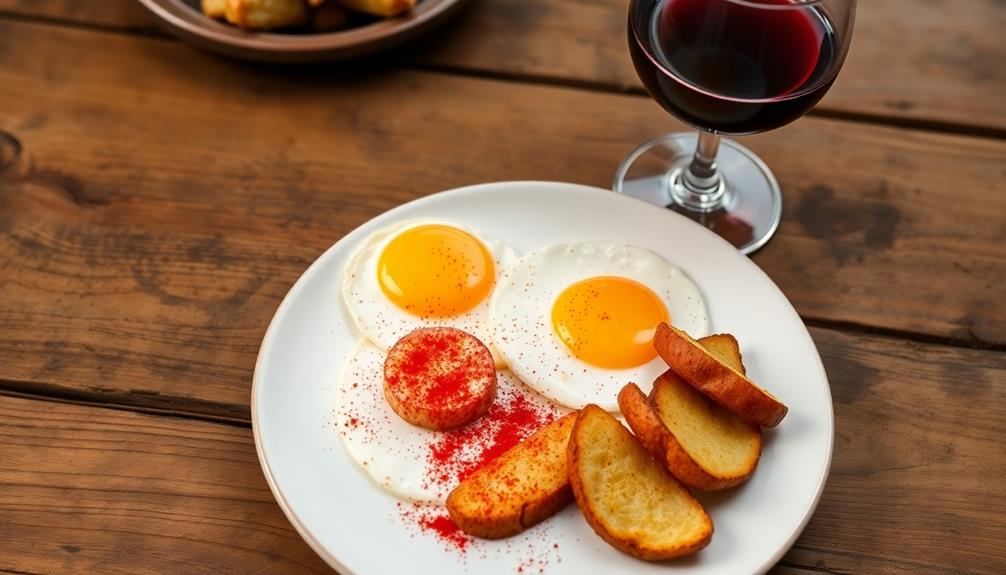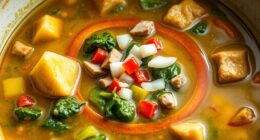Roast suckling pig is a celebrated culinary delight with roots in ancient civilizations. This tender, succulent dish has captivated cultures worldwide, often featured in festive gatherings as a symbol of wealth and prosperity. To prepare this mouthwatering centerpiece, you'll need a whole suckling pig, carefully seasoned and roasted to perfection. The key is to baste the meat regularly, maintaining moisture and achieving that irresistible crispy skin. Serve it alongside roasted potatoes and fresh salads for a harmonious feast. If you're eager to learn more about the rich history and techniques behind this captivating dish, keep reading.
Key Takeaways
- Suckling pig is a traditional dish with ancient origins, often used in religious ceremonies and celebrations across various cultures.
- Proper preparation involves thorough cleaning, seasoning, marination, and precise roasting techniques to achieve a crispy, golden-brown skin and tender meat.
- Roasting at consistent temperatures, typically 250°F to 300°F, for 2-3 hours until the internal temperature reaches 145°F is recommended.
- Basting the pig periodically with pan juices helps maintain moisture and enhance the crispy skin texture.
- Serving the roast suckling pig with traditional sides like roasted potatoes, fresh salads, and sauces like apple sauce or chimichurri complements the rich, flavorful dish.
History
Roasted suckling pig has been a culinary tradition for thousands of years, with its origins tracing back to ancient civilizations. The practice of roasting young pigs whole dates back to the Mesopotamian and ancient Greek cultures, where it was often used in religious ceremonies and festive celebrations.
During the Roman Empire, the roast suckling pig became a symbol of wealth and prestige, with elaborate feasts featuring the tender, juicy meat. As the Roman influence spread across Europe, the tradition of cochinillo asado, or roast suckling pig, took root in Spain and other parts of the continent.
In the New World, Spanish colonizers introduced the dish to Latin America, where it remains a beloved regional specialty, particularly in countries like Mexico and Peru.
Today, the roast suckling pig continues to be a cherished part of many cultural and culinary traditions around the globe, beloved for its rich flavor and tender, melt-in-your-mouth texture.
Recipe
A succulent roast suckling pig is a true culinary delight, a centerpiece for any special occasion. The tender, juicy meat and crisp, golden skin create a harmonious blend of flavors and textures that will leave your guests in awe.
Preparing a roast suckling pig requires attention to detail and patience, but the end result is well worth the effort. The key is to strike the perfect balance between the delicate nature of the young pig and the robust flavors that complement it.
- 1 whole suckling pig, approximately 10-15 pounds
- 2 tablespoons kosher salt
- 1 tablespoon black pepper
- 2 tablespoons olive oil
- 4 cloves garlic, minced
- 2 sprigs fresh rosemary
- 2 sprigs fresh thyme
Preheat your oven to 425°F (220°C). Pat the suckling pig dry with paper towels and generously season the skin and cavity with salt and pepper. Rub the olive oil all over the skin, then sprinkle the minced garlic and tuck the rosemary and thyme sprigs into the cavity.
Place the pig on a rack in a large roasting pan and roast for 30 minutes. Reduce the temperature to 325°F (165°C) and continue roasting for 2-3 hours, or until the internal temperature reaches 145°F (63°C) and the skin is crisp and golden brown.
It's important to baste the pig every 30 minutes with the rendered fat in the pan to ensure even cooking and a beautiful, glistening exterior.
Allow the roast to rest for 15-20 minutes before carving and serving. The low and slow cooking method ensures the meat is incredibly tender and flavorful. Enjoy this spectacular dish with your loved ones!
Cooking Steps
First, prepare the suckling pig by thoroughly seasoning its skin with a savory rub.
Then, roast the pig in a preheated oven, basting it with the pan juices periodically to ensure a crispy, golden-brown exterior.
Step 1. Prepare the Suckling Pig
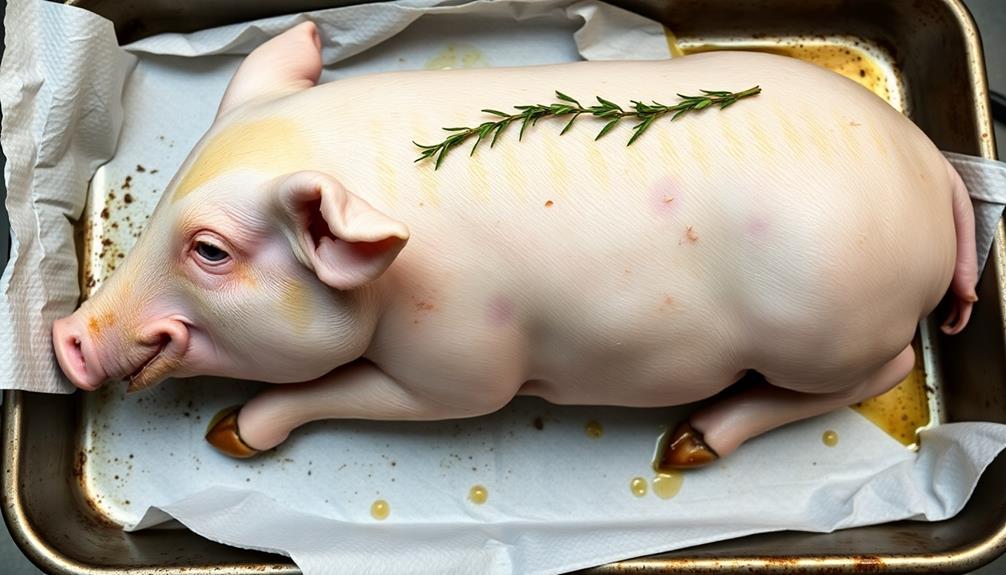
Preparing the suckling pig for roasting involves several crucial steps. First, thoroughly clean the pig by removing any hair, excess fat, and the internal organs. Gently pat the skin dry with paper towels.
Next, rub the skin with a generous amount of salt, ensuring an even coating. This will help create that irresistible crispy skin.
For added flavor, you can also massage the meat with a blend of aromatic herbs and spices, such as garlic, rosemary, and black pepper. Make sure to get the seasoning under the skin as well.
Truss the pig using kitchen string, tying the legs and the snout to maintain a compact shape during roasting.
Place the prepared suckling pig on a rack in a roasting pan, and let it rest for about 30 minutes at room temperature before popping it in the oven. This will help the meat cook evenly.
Now you're ready to roast the pig to perfection, filling your home with the mouthwatering aroma of this beloved holiday dish.
Step 2. Rub Seasoning Onto Skin
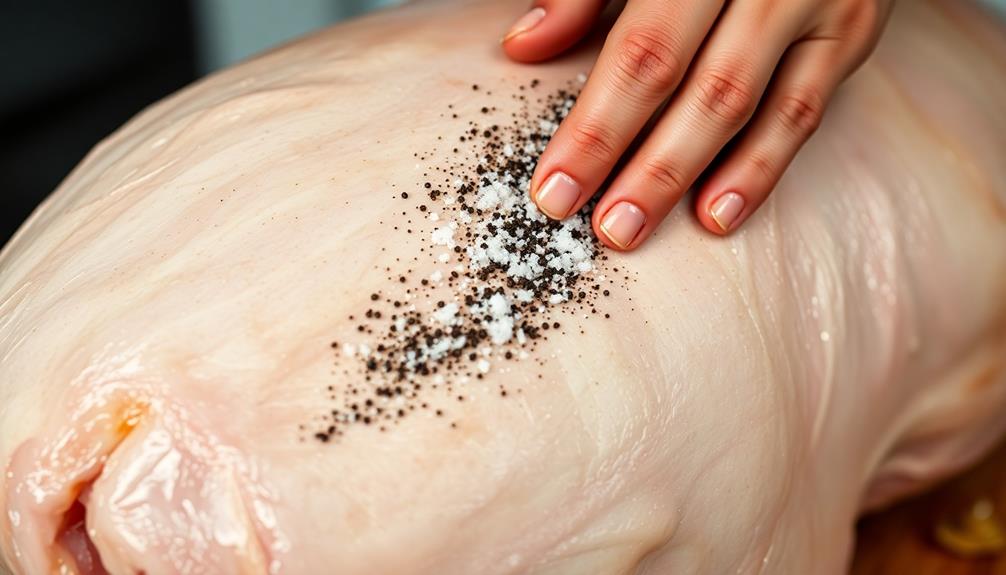
After thoroughly cleaning the suckling pig, it's time to season the skin. Grab a bowl and combine a mix of aromatic spices – perhaps paprika, garlic powder, oregano, and a pinch of salt and pepper.
Gently rub this fragrant seasoning all over the skin, ensuring even coverage. Don't be afraid to get your hands dirty! Massage the blend into every nook and cranny, including the crevices and the underside. This will help the flavors penetrate deep into the meat, resulting in a mouthwatering, flavorful roast.
Once the skin is fully coated, use kitchen twine to tie the pig's legs together, keeping the shape compact for even cooking. Tuck the wings or ears under the body to prevent them from burning.
Step 3. Roast in Preheated Oven
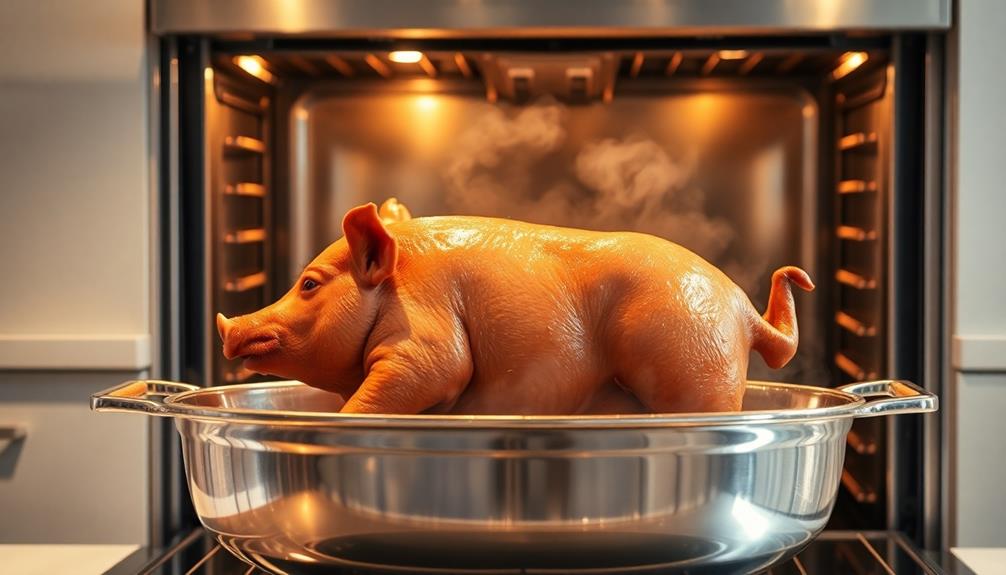
Preheat your oven to 400°F (200°C).
Once it's hot, carefully place the prepared suckling pig on the roasting rack. Make sure the skin side is facing up so it gets nice and crispy.
Roast the pig for 2-3 hours, basting it every 30 minutes with the juices in the pan. Keep an eye on it and adjust the temperature if needed to prevent burning.
The internal temperature should reach 145°F (63°C) when measured in the thickest part of the meat.
Once it's done, take the pig out of the oven and let it rest for 15-20 minutes. This allows the juices to redistribute throughout the meat.
Carve the roast suckling pig at the table for a dramatic presentation.
Serve it with your favorite sides like roasted potatoes, sautéed greens, and applesauce.
Enjoy this classic, mouthwatering dish with family and friends!
Step 4. Baste With Pan Juices Periodically

Every 30 minutes, baste the succulent roast with the savory juices accumulating in the pan. Use a basting brush or spoon to gently coat the skin, ensuring even coverage.
This process helps lock in moisture and enhances the crispy, golden-brown texture of the pork. The juices will continually develop as the pig cooks, so be sure to baste thoroughly each time.
You'll notice the aromas intensifying with each pass, making your mouth water in anticipation. Basting not only bastes the surface but also incorporates those delectable flavors back into the meat.
Keep a close eye on the roast, basting every half-hour to prevent the skin from drying out. This simple step is crucial for achieving the perfect, glossy finish on your magnificent suckling pig.
The anticipation builds with each baste, as you eagerly await the moment to carve and serve this impressive centerpiece.
Step 5. Let Meat Rest Before Carving
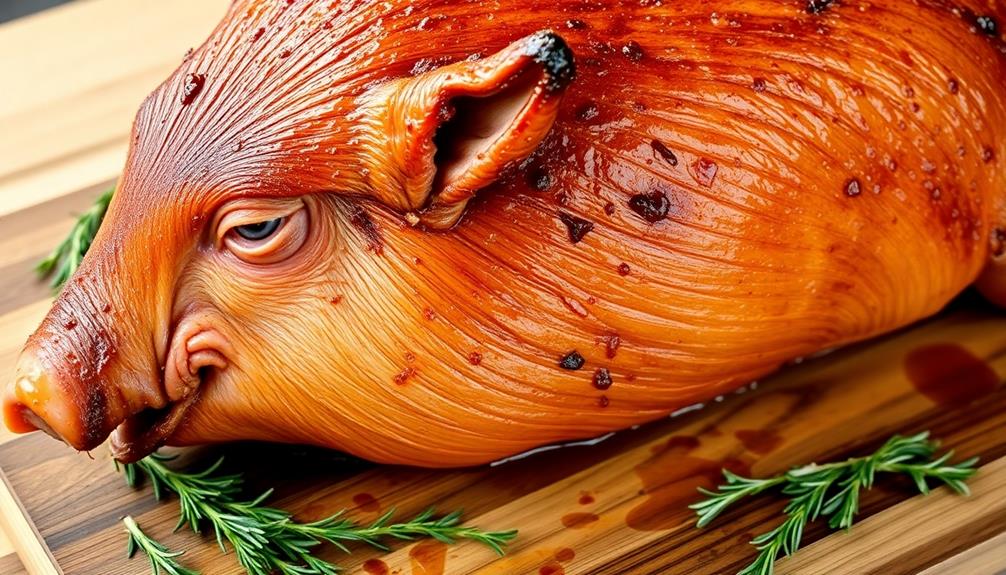
Once you've finished basting the roast, your work isn't quite done. Before you can dig in, you'll need to let the meat rest. This crucial step allows the juices to redistribute throughout the pork, ensuring each bite is succulent and flavorful.
Give your roast a good 15-20 minutes to rest on the cutting board. Resist the temptation to start carving right away – patience will pay off! During this time, the internal temperature of the meat will continue to rise a few degrees, and the juices will have a chance to settle.
When you're ready to serve, use a sharp carving knife to slice through the crispy skin and tender meat. Slice against the grain for the most tender bites.
Arrange the slices on a platter and enjoy your labor of love! The resting period makes all the difference, so don't skip this step. Your guests will savor every morsel of your perfectly cooked suckling pig.
Final Thoughts
Preparing a roast suckling pig is a delightful culinary adventure that requires patience, precision, and a touch of culinary artistry. From selecting the perfect piglet to mastering the art of crispy skin and tender, juicy meat, every step of the process is a testament to the skill and dedication of the chef.
Once the pig has rested and the meat has been carved, it's time to savor the fruits of your labor. The delicate, melt-in-your-mouth texture of the meat, combined with the irresistible crunch of the golden-brown skin, creates a symphony of flavors that will delight your senses.
Serve the succulent slices with your favorite accompaniments, like roasted potatoes or a fresh green salad, and let your guests revel in the indulgence of this exceptional dish. For a truly unforgettable meal, consider pairing the tender slices of meat with a creamy risotto or garlic mashed potatoes. And if you’re looking to impress your guests even further, try serving it alongside a rich and flavorful seafood stew recipe. The combination of savory beef and delectable seafood will elevate your dining experience to new heights, leaving everyone at the table satisfied and eager for seconds.
As you bask in the glow of your culinary triumph, remember that the joy of preparing a roast suckling pig extends far beyond the plate. It's a shared experience that brings people together, celebrating the art of fine dining and the timeless traditions that make it so special.
Frequently Asked Questions
Is Suckling Pig Safe for Pregnant Women to Consume?
You should avoid consuming suckling pig while pregnant as it may contain harmful bacteria that could put your baby at risk. It's best to consult your doctor before eating any unpasteurized or undercooked meats during pregnancy.
Can I Substitute Pork Belly for a Suckling Pig?
You can substitute pork belly for a suckling pig, as they share similar textures and flavors. However, keep in mind that pork belly may not have the same tenderness and delicate taste as a true suckling pig.
How Long Will Leftover Suckling Pig Keep in the Fridge?
Leftover suckling pig will keep in the fridge for 3-4 days, but you'll want to store it in an airtight container. Consume it quickly for the best flavor and texture.
Can I Find Suckling Pig at My Local Grocery Store?
You may have trouble finding suckling pig at your local grocery store. Suckling pig is a specialty item, often found at ethnic markets or ordered directly from farms. Check with your local butcher to see if they can order it for you.
Is It Possible to Make Suckling Pig in a Slow Cooker?
You might be able to make suckling pig in a slow cooker, but it's not the traditional method. The slow cooker may not provide the crisp skin and tender meat you'd expect from roasting the whole suckling pig.



